#product engineering company in usa
Text
Teksun's Cognitive Services & Solutions includes a wide set of tools and frameworks that allow businesses to operationalize AI services quickly, and at scale. To know more about browse: https://teksun.com/ Contact us ID: [email protected]
#Teksun#CognitiveServices#AI#AItools#AIsolutions#AIframeworks#OperationalizeAI#ScaleAI#BusinessAI#BusinessSolutions#product engineering services#product engineering company in usa#digital tranformation company in usa#teksuninc#teksun
0 notes
Text

Embark on a global bug hunt with our SDET team, leveraging cloud-based mobile testing to ensure your app achieves flawless performance across all devices and networks. With cutting-edge tools and a meticulous approach, we identify and eliminate bugs before they impact your users. https://rb.gy/jfueow #SDET #BugHunt #CloudTesting #MobileAppQuality #FlawlessPerformance SDET Tech Pvt. Ltd.
#Software Testing Companies in India#Software Testing Services in India#Test Automation Development Services#Test Automation Services#Performance testing services#Load testing services#Performance and Load Testing Services#Software Performance Testing Services#Functional Testing Services#Globalization Testing services#Globalization Testing Company#Accessibility testing services
Agile Testing Services#Mobile Testing Services#Mobile Apps Testing Services#ecommerce performance testing#ecommerce load testing#load and performance testing services#performance testing solutions#product performance testing#application performance testing services#software testing startups#benefits of load testing#agile performance testing methodology#agile testing solutions#mobile testing challenges#cloud based mobile testing#automated mobile testing#performance engineering & testing services#performance testing company#performance testing company in usa
0 notes
Text

The pressing question now is whether to host the mobile testing process internally or to leverage one of the many cloud-based mobile testing tools available today. Click Here:https://shorturl.at/VGKgh
#Software Testing Companies in India#Software Testing Services in India#Test Automation Development Services#Test Automation Services#Performance testing services#Load testing services#Performance and Load Testing Services#Software Performance Testing Services#Functional Testing Services#Globalization Testing services#Globalization Testing Company#Accessibility testing services
Agile Testing Services#Mobile Testing Services#Mobile Apps Testing Services#ecommerce performance testing#ecommerce load testing#load and performance testing services#performance testing solutions#product performance testing#application performance testing services#software testing startups#benefits of load testing#agile performance testing methodology#agile testing solutions#mobile testing challenges#cloud based mobile testing#automated mobile testing#performance engineering & testing services#performance testing company#performance testing company in usa
1 note
·
View note
Text
TNTRA: Empowering Innovation Through IP-Led Software Product Engineering in the USA
TNTRA is a leading IP-led software product engineering company based in the USA. With a commitment to innovation, we specialize in developing cutting-edge software solutions that empower businesses to thrive in today's dynamic market. Our team of skilled engineers utilizes intellectual property strategies to deliver bespoke software products tailored to the unique needs of our clients. Visit us at https://www.tntra.io/us/software-engineering-usa to explore how TNTRA is redefining the future of software engineering in the United States
0 notes
Text
Amazon's bestselling "bitter lemon" energy drink was bottled delivery driver piss

Today (Oct 20), I'm in Charleston, WV at Charleston's Taylor Books from 12h-14h.

For a brief time this year, the bestselling "bitter lemon drink" on Amazon was "Release Energy," which consisted of the harvested urine of Amazon delivery drivers, rebottled for sale by Catfish UK prankster Oobah Butler in a stunt for a new Channel 4 doc, "The Great Amazon Heist":
https://www.channel4.com/programmes/the-great-amazon-heist
Collecting driver piss is surprisingly easy. Amazon, you see, puts its drivers on a quota that makes it impossible for them to drive safely, park conscientiously, or, indeed, fulfill their basic human biological needs. Amazon has long waged war on its employees' kidneys, marking down warehouse workers for "time off task" when they visit the toilets.
As tales of drivers pissing – and shitting! – in their vans multiplied, Amazon took decisive action. The company enacted a strict zero tolerance policy for drivers returning to the depot with bottles of piss in their vans.
That's where Butler comes in: the roads leading to Amazon delivery depots are lined with bottles of piss thrown out of delivery vans by drivers who don't want to lose their jobs, which made harvesting the raw material for "Release Energy" a straightforward matter.
Butler was worried that he wouldn't be able to list his product on Amazon because he didn't have the requisite "food and drinks licensing" certificates, so he listed his drink in Amazon's refillable pump dispenser category. But Amazon's systems detected the mismatch and automatically shifted the product into the drinks section.
Butler enlisted some confederates to place orders for his drink, and it quickly rocketed to the top of Amazon's listings for the category, which led to Amazon's recommendation engine pushing the item on people who weren't in on the gag. When these orders came in, Butler pulled the plug, but not before an Amazon rep telephoned him to pitch him turning packaging, shipping and fulfillment over to Amazon:
https://www.wired.com/story/amazon-let-its-drivers-urine-be-sold-as-an-energy-drink/
The Release Energy prank was just one stunt Butler pulled for his doc; he also went undercover at an Amazon warehouse, during a period when Amazon hired an extra 1,000 workers for its warehouses in Coventry, UK, in a successful bid to dilute pro-union sentiment in his workforce in advance of a key union vote:
https://jacobin.com/2023/10/the-great-amazon-heist-oobah-butler-review
Butler's stint as an Amazon warehouse worker only lasted a couple of days, ending when Amazon recognized him and fired him.
The contrast between Amazon's ability to detect an undercover reporter and its inability to spot bottles of piss being marketed as bitter lemon energy drink says it all, really. Corporations like Amazon hire vast armies of "threat intelligence" creeps who LARP at being CIA superspies, subjecting employees and activists to intense and often illegal surveillance.
But while Amazon's defensive might is laser-focused on the threat of labor organizers and documentarians, the company can't figure out that one of its bestselling products is bottles of its tormented drivers' own urine.
In the USA, the FTC is suing Amazon for its monopolistic tactics, arguing that the company has found ways to raise prices and reduce quality by trapping manufacturers and sellers with its logistics operation, taking $0.45-$0.51 out of every dollar they earn and forcing them to raise prices at all retailers:
https://pluralistic.net/2023/04/25/greedflation/#commissar-bezos
The Release Energy stunt shows where Amazon's priorities are. Not only did Release Energy get listed on Amazon without any quality checks, the company actually nudged it into a category where it was more likely to be consumed by a person. The only notice the company took of Release Energy was in its logistics and manufacturing department – the part of the business that extracts the monopoly rents at issue in the FTC case – which tracked Butler down in order to sell him these services.
The drivers whose piss Butler collected don't work directly for Amazon, they work for a Delivery Service Partner. These DSPs are victims of a pyramid scheme that Amazon set up. DSP operators lease vans and pay to have them skinned in Amazon livery and studded with Amazon sensors. They take out long-term leases on depots, and hire drivers who dress in Amazon uniforms. Their drivers are minutely monitored by Amazon, down to the movements of their eyeballs.
But none of this is "Amazon" – it's all run by an "entrepreneur," whom Amazon can cut loose without notice, leaving them with unfairly terminated employees, outstanding workers' comp claims, a fleet of Amazon-skinned vehicles and unbreakable facilities leases:
https://pluralistic.net/2022/04/17/revenge-of-the-chickenized-reverse-centaurs/
Speaking to Wired, Amazon denied that it forces its drivers to piss in bottles, but Butler clearly catches a DSP dispatcher telling drivers "If you pee in a bottle and leave it [in the vehicle], you will get a point for that" – that is, the part you get punished for isn't the peeing, it's the leaving.
Amazon's defense against the FTC is that it spares no effort to keep its marketplace safe. As Amazon spokesperson James Drummond says, they use "industry-leading tools to prevent genuinely unsafe products being listed." But the only industry-leading tools in evidence are tools to bust unions and screw suppliers.
In her landmark Yale Law Review paper, "Amazon's Antitrust Paradox," FTC Chair Lina Khan makes a brilliant argument that Amazon's alleged benefits to "consumers" are temporary at best, illusory at worst:
https://www.yalelawjournal.org/note/amazons-antitrust-paradox
In Butler's documentary, Khan's hypothesis is thoroughly validated: here's a company extracting hundreds of billions from merchants who raise prices to compensate, and those monopoly rents are "invested" in union-busting and countermeasures against investigative journalists, while the tools to keep you from accidentally getting a bottle of piss in the mail are laughably primitive.
Truly, Amazon is the apex predator of the platform era:
https://pluralistic.net/ApexPredator

If you'd like an essay-formatted version of this post to read or share, here's a link to it on pluralistic.net, my surveillance-free, ad-free, tracker-free blog:
https://pluralistic.net/2023/10/20/release-energy/#the-bitterest-lemon

My next novel is The Lost Cause, a hopeful novel of the climate emergency. Amazon won't sell the audiobook, so I made my own and I'm pre-selling it on Kickstarter!
#pluralistic#release energy#channel 4#amazon#corporate intelligence#labor#unions#amazon labor union#the great Amazon heist#catfish uk#oobah butler#delivery service partner
7K notes
·
View notes
Text

1963 AC SHELBY COBRA
1963 AC SHELBY COBRA 4.7-LITRE MARK II ROADSTER
REGISTRATION NO. OYM 28A
CHASSIS NO. CSK2116
ENGINE NO. CSX2116
Footnotes
Rightly regarded as one of the all-time great classic sports cars, the muscular, fire-breathing Cobra succeeded in capturing the hearts of enthusiasts like few of its contemporaries. Only 1,000-or-so Cobras of all types were built between 1962 and 1967, but such was the model's enduring popularity that production was resumed in 1982 under the auspices of Brooklands-based Autokraft.
Convinced that a market existed for an inexpensive sports car combining European chassis engineering and American V8 power, Le Mans-winning Texan racing driver Carroll Shelby concocted an unlikely alliance between AC Cars and the Ford Motor Company. The former's Ace provided the simple twin-tube chassis frame - designed by John Tojeiro - into which was persuaded one of Ford's lightweight, small-block V8s. It was discovered that the latter was lighter than the six-cylinder Ford Zephyr unit that AC was using, yet with vastly greater potential. To cope with the projected power increase, the Ace chassis was strengthened with heavier gauge tubing and supplied fitted with four-wheel disc brakes. Weighing a mere 1.5cwt more than a Bristol-engined Ace yet endowed with double the power and torque, the Cobra turned in a breathtaking performance, racing to 60mph in 4.4 seconds and reaching the 'ton' in under 12, exceptional figures by early 1960s standards and none too shabby even today.
The 260ci (4.2-litre) prototype first ran in January 1962, with production commencing later that year. Exclusively for the USA initially, Cobras - minus engines - were sent from England to be finished off by Shelby in California, and it was not until late in 1963 that AC Cars in Thames Ditton got around to building the first fully finished cars to European specification.
After 75 Cobras had been built with the 260ci engine, the more powerful 289ci (4.7-litre) unit was standardised in 1963. Rack-and-pinion steering was the major MkII up-date; then in 1965 a new, stronger, coil-suspended MkIII chassis was introduced to accommodate Ford's 427ci (7.0-litre) V8, an engine that in race trim was capable of producing well in excess of 400bhp. Wider bodywork, extended wheelarch flares and a bigger radiator intake combined to create the definitive - and much copied - Cobra MkIII look. Keeping ahead of the competition on the racetrack had been the spur behind Shelby's adoption of the 427 engine, but some MkIIIs to 'street' specification came with Ford's less powerful 428ci hydraulic-lifter V8.
But for Brian Angliss, the Cobra story would have ended in 1967. The Autokraft boss had built up a business restoring Cobras and supplying parts, and in the early 1980s acquired the rights to the AC name plus a quantity of jigs and tooling from the old Thames Ditton factory. Keeping the overall style of the MkIII, Autokraft produced the MkIV, which was appropriately updated to meet current legislation and powered by a 'Federalised' Ford 5.0-litre V8 engine. Around 480 were built.
Chassis number 'CSX2116' was invoiced to Shelby American on 16th April 1963 and shipped to Los Angeles three days later aboard the 'SS Loch Gowan'. Invoiced on 18th June 1963 to Burton Motors of Sacramento, California, the Cobra was sold new to a local doctor who used it for a few years before giving it to his daughter. She used the car as daily transport for several years before the clutch failed, at which time it was sold to Steve Dangremond of Santa Rosa, California. The Cobra was advertised for sale by Mr Dangremond in late 1977 and bought by Dr Grant Hill of Chotoka, Alberta. Dr Hill fitted Weber carburettors and raced 'CSX2116', eventually trading it to Fred Yule in Portland, Oregon. At that time, the car was still finished in its original colour scheme of dark blue and retained its original black leather interior.
'CSX2116' returned to the UK in the late 1980s and was advertised through Hampson's Ltd, by which time it had been refinished in red and fitted with a full-width roll bar. Subsequent owners in England were Dr Carlos Barbot, Trojan boss Peter Agg and Formula 1 racing driver Rupert Keegan. 'CSX2116' was last restored in 1988, records on file indicating that an extensive mechanical restoration was undertaken at this time. The car still retains its original black leather interior though the Weber carburettors have gone, replaced by an easier to maintain four-barrel Holley. There is considerable additional accompanying documentation including correspondence between previous owners, a copy of the original bill of sale, Shelby American Automobile Club letter of authentication, FIA papers and Swansea V5 registration document. The car has belonged to the current owner since 2006.
Early Cobras are offered for sale only rarely and this example represents a wonderful opportunity to acquire a fine example of this classic of Anglo-American sports car design.
90 notes
·
View notes
Text
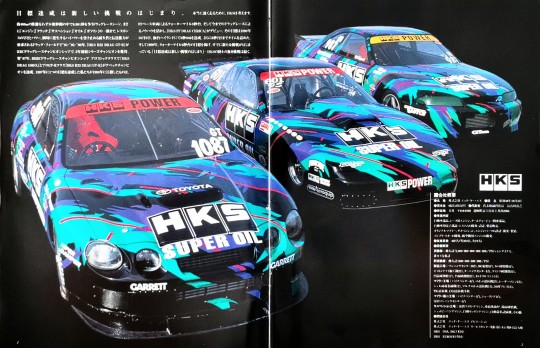
Achieving a goal is the beginning of a new challenge. To run really fast, HKS thinks.
A drag race scene where people compete for 0.001 seconds over a distance of about 400 meters in just a few seconds. '91 is a drag field that demands quick response and power from the engine, clutch, suspension, and even a single drop of oil or gasoline, as well as durability and transmission ability to handle instantaneous high power. -In '95-'96, the ``HKS R32 DRAG GT-R'' won the series championship in the RRC Drag Race Championship for three consecutive years. The following year, in 1997, the ``HKS DRAG 180SX'' in the BERC Drag Race Championship Pro Stock class and the ``HKS R33 DRAG GT-R'' in the Pro GT-R class achieved the Avec Championship. Having achieved one goal in 1997, what we aimed for in 1998 is:
Quarter mile time in 9 seconds with FF base vehicle. They then talked about their know-how from drag racing to date, and ``HKS FF DRAG CELICA'' made its debut. The first goal was achieved on October 9, 1998 at Sendai Highlands with a time of 9.886 seconds. He further improved his time to 9.727 seconds, and in 1999 he set a goal of breaking the quarter mile in the 6-second range, and has already begun a new challenge. "Achieving a goal is the beginning of a new challenge" - HKS' never-ending battle continues
HKS
■Company overview
●Name HKS Co., Ltd. Established October 31, 1971
●Capital 607,475/Kawa Representative Director and President Naruyuki Hasegawa
●Location Head Office 2266 Kamiogawa, Kunikami City, 418-0192
●Business details
Development, design, and product sales of automobile parts, racing engines, turbocharger-related parts, and automotive components and systems Design, development, and manufacturing of original mufflers, suspensions, and engine parts Development of complete cars, development of aircraft engines
●Number of employees: 407 (333%, 74 women)
●Equipment overview
Experiment building: Dynamometer (1,000/800/600~300/200/PS) Chassis dynamo, exhaust gas analyzer
Old experimental building: Dynamometer (600/600-500-200/PS)
Manufacturing factory: 10ft machining center, 5 NC lathes, 41 cam polishing machines, 21 biston narai, 11 turning centers, 21 crank Kenjoshi, Monzen Kendanmei, 21 surface grinders, 1 gun drill machine.
Muffler factory: Pipe bender, robot welding machine, 1 laser machine, shell machine, multi-spot welding machine 11, 100T press, TIG welding machine, CO2 welding machine multi-stage
Muffler 2nd factory: Pipe bender / shirring / Yasuda machining center 1 piece
Suspension factory: Cold solid coiling machine, continuous coiling machine, surface grinding machine, shot peening machine, automatic setting machine, automatic load testing machine, etc.
●Affiliated companies
HKS Aviation Co., Ltd. HKS Service Center (Tokyo/West/Kyu)
HKS USA, INC (USA)
HKS EUROPE()
23 notes
·
View notes
Note
question: is the salary for race engineer really 60-70k per annum? why did i think they get paid way more???? 😭
sorry idk why this answer is so long i'm putting it under the cut 😭
but hahaha uk engineering salaries are generally fairly low afaik, for ex in the usa entry level swe salaries at big companies are easily 6 figs but i've heard that in the uk 40k is a pretty decent base pay? (sorry if i sound like an idiot @ uk followers 😭 or if you yourself are british anon then i apologize as well 💔) obviously that's in pounds but purely numerically indy/nascar engineers probably get paid a lot better than those in f1 because you have to contextualize benefits and col and so on... this is probably off-topic sorry moving on
but in general it's worth noting that f1 is an environment that preys on the sentimentalism of its applicant pool (i.e. "passion job"); it's much easier to exploit employees who care deeply about the product they're involved in because it's something they've dreamed of their whole lives and manufactured their entire academic journeys around attaining. f1 is both extremely stressful and pays comparatively poorly for a majority of its mechanics and engineers — when you think about the strain of travelling, trackside personnel (just as an example, ofc only a small # of engineers travel) often arrive earlier and stay later than the drivers & their wages are low because teams know there's enough competition that highly qualified candidates will continue applying regardless. so you basically need to be 1) willing to work for not very much 2) willing to work a shit ton of overtime and 3) willing to sacrifice your social life to hack it. you'll hear a lot of anecdotes from people who were like hm i thought i wanted to work in f1 but i realized it wasn't worth the stress and just got a normal cushy tech job for twice the pay LOL
anyway idk how much gp specifically makes though very senior engineers could definitely be higher than that, but i'd be quite surprised if it was That much more than 100k? (just for base pay ofc) esp in cost cap era... 🥲 i could be talking out of my ass though!!! that's just the general impression i've gotten hsdflkh
#apologies for the literal essay. idk why i wrote all that#if anyone has intimate knowledge of avg f1 race engineer salaries please feel free 2 correct me <3#ask#also in my head oscar is still like fairly young and hasn't been a race engineer for that long which is why it's not that high#not to overthink fictional oscar piastri's race engineer salary.#kind of funny though that he currently makes like 2mil to lando's alleged 20mil
11 notes
·
View notes
Text
I am posting this for notes purposes, because we are going to be contacting many of these companies to pitch SIX Of Crows! ;)
The following companies are looking for new TV pitches for development & production.
Campaign - Production Companies
20th Century Fox Television
20th TV, Fox and MyNetworkTV
2C Media
3 BALL PRODUCTIONS
3 Ball Productions/Eyeworks USA
3 Ring Circus
360Production
40 Partners
720 PR
8790 Pictures,Inc.
ABC Cable Networks
ABC Entertainment
ABC Studios
Abrams Artists Agency
Adept Entertainment
Alan David Group
Alchemy Television
Alchemy Television Group
Alcon Entertainment
Allan McKeown Presents Ltd
Allan R. Smith Productions
Ambush Entertainment
American Media Television
Anne Carlucci Productions, Inc.
APA
Arclight Films
Arjay Entertainment Television
Artist International
Asylum Entertainment
AT IT Productions
Atlas Media Corp
Automatic Pictures
Avalon Television USA
Axelson-Weintraub Entertainment
Banner-Caswell Productions
BBC Worldwide
BCII
Beth Grossbard Productions
Big Cattle Productions
Big Hill Pictures
Boulevard Pictures
Boxing Cats Productions
Boz Productions
Brian Graden Media
Broken Lizard Industries
Buck Productions
Buck Productions Inc.
CAA
Cakehouse Media
Capestany Films
CartoonNetwork
Cataland Films
Cavelight Films
CBS
CBS Entertainment
CBS Films
CBS Interactive
CBS Paramount
CBS Paramount Network Television
CBS Studios International
CBS Television Distribution
CBS Television Studios
Central Artists
Champion Entertainment
Clear Pictures Entertainment
Codeblack Entertainment
Codeblack Films/Lionsgate
Collins Avenue
CoLours TV
cosmic pictures
Creative Chaos Inc.
Creative Convergence
DASH Networks
DatsEntertainment
De Line Pictures
Digital Alchemy Entertainment Inc.
Disney Channel
diverse talent group
Dragonfly Film and TV
E'lan Productions
Echelon Studios
Echo Lake Productions
Echo Production Company, Inc
Edmonds Entertainment
Edward Saxon Productions
Electric Entertainment
Elkins Entertainment
Ellman Entertainment
Enchanted Rock Pictures/MTS Entertainment
Endemol USA
Endgame Entertainment
Ensemble Entertainment
Entertainment Studios, Inc
Epic Level Entertainment
Epiphany Pictures
Espiritus Productions
Evatopia
Eventime Productions
Evolution Entertainment
Eyeworks Belgium NV
Fauci Productions, Inc.
Faultline Films ltd
Film 44
Film Garden Entertainment
Firehorse Pictures
Fireworks Enterprises
Fisher Entertainment Group
Forward Entertainment, llc
Fox Broadcasting
Fox Interactive Media
Fox International Channels
Fox Searchlight Pictures
FOX Sports
Fox Television Studios
Frontlot Productions
FX Network
Generate
Goliath
Grand Productions Inc
GRB Entertainment
Greene & Associates Talent Agency
Greenspan Kohan Mgt.
Handmade Films
Harper Winslow Productions
HBO
HDNet
Here Media
Homerun Entertainment
Honest Engine Films
Hope Enterprises, Inc.
Ideas Unlimited - TV (Denmark)
Idiomatic Entertainment
IKA Collective
Imbroglio Pictures Inc. / Scott & Cooper Entertainment Ventures
Innovative Artists
insomnia media group
Inspire Films and Television
International Creative Management
Intuitive Entertainment
IWV Media Group, Inc.
Jackamo Television Ltd
Jane Street Entertainment
Jeff Ross Entertainment
Jupiter Entertainment
Just SInger Entertainment
Kaplan-Stahler Agency
Ken Ehrlich Productions
Kickstart Productions, Inc.
Kingfish Productions
klasky csupo, inc.
KoldCast TV
Komixx Entertainment
Konigsberg Company
Kritzer Levine Wilkins Griffin Entertainment
Laika Entertainment
Legion Entertainment LLC
Lionsgate
Lionsgate Television
Little Dog Productions
LITTLE STUDIO FILMS
Litton TV
Lucky 8 TV
M Creative Group, Inc.
Madeline Films
Madhouse Entertainment
Madison Road Entertainment
Magical Elves
Magnet Management
Magnolia Entertainment
Mandeville Films Inc
Mandt Bros. Productions
Mango Tree Films
Manville Media
Mark Yellen Productions
Mashaal Media Corp.
Mass Hysteria Entertainment
Matrixx Prod.
Mayhem Pictures
Media 8 Entertainment
MGM
Michael Berk Productions
Michael Grais Prods.
Michael Levy Enterprises
Microsoft Corporation
Moniker Entertainment
Moxie Pictures
MPH Entertainment, Inc.
Mpower Pictures
Mt. Vernon Entertainment
myriad pictures
National Geographic Digital Media
National Lampoon/ Comedy Cocktail
NBC/Universal | Mun2
Neon Television
Network Entertainment Inc.
New Wave Entertainment
Noble Savages
Nu Image
Nu Image / Millennium Films
Nu Image/Millennium Films
Oceanside Entertainment
Ocular Production Inc.
One Entertainment
PalmStar Entertainment
Panic Productions, Inc.
Paradigm Agency
Paramount Digital Entertainment
Paramount Network
Paul Schiff Productions
Paulist Productions
Phoenix Pictures
Pie Town productions
Planet Grande Pictures
Planet Pictures
Playboy Entertainment Group
Plymouth Rock Entertainment, Inc.
Pogo Pictures
Popular Arts Entertainment
Porchlight Entertainment
Port Magee Pictures, Inc.
PorterGeller Entertainment
POW! Entertainment
preferred artists
Principal Entertainment
Principato Young
Principato-Young Entertainment
PrizmHead Pictures
Rain Management Group
Rainstorm Entertainment
RDF USA
RDS FILM
Red Baron Films
Reel Entertainment
Reid Media Group, Inc.
Revelations Entertainment
Reyes Entertainment
Right Brain Media
ROAR
Rob Gallagher Literary Management
ROBBINS ENTERTAINMENT GROUP
Rudolph Films Inc
S.L Entertainment
SB Productions Inc.
Scream Films (UK Based)
Shatner Universe
ShineReveille International
ShootersTV
Sidney Kimmel Entertainment
Sigh Griffin Management
Slate of Eight Productions
Smash Media
Smoke and Mirrors Creative / Pandemonium Films
Solar Films Inc
Sony Pictures
Sony Pictures International TV
Sony Pictures Television
Sony Pictures Television International
Sony Pictures TV
Sony Television
SPEED Channel
Sports Branded Media
Starz
Starz Media
State Street Pictures
Station3
Storytime Films
Stowaway Films
Telecast productions
Tell Tale Productions
test
The Corsa Agency
THE GERLER AGENCY
The Gersh Agency
The Gersh Agency, L.A.
THE MAK COMPANY
The Sterling/Winters Production Studios
The Televisionaries
The Terminal
The Wolper Organization
The Wolper Organization / WBTV
Thousand Hills Productions
ThunderBall Films, LLC
Touchdown Television
Trevino Enterprises
Trilogy Entertainment Group
TV Guide Network
Twentieth Century Fox Television
Twentieth Television
Underground Films
Underground Films and Management
Union Entertainment
United Talent Agency
Universal Studios
UTA
Valencia Corp
Venture IAB
ViacomCBS
VPR Media
Walt Disney Company
Walt Disney Studios
Walt Disney Studios Motion Picture Production
Washington Square Films
Wayans Brothers Prod.
Weller/Grossman Productions
Wide Angle Productions Group, Inc.
Wildbrain Entertainment
William Morris Endeavor
Wolf Moon Films
Zero gravity
Zero Gravity Management
Zilo Networks Inc.,
Zucker Productions
19 notes
·
View notes
Photo










Enterra Vipre
The Enterra Vipre was developed in the mid-1980s by a group of waiters at the Keg Restaurant on Vancouver’s Granville Island. Somehow they managed to secure a grant from the Canadian Scientific Research Council for $10 million CAD, and perhaps not surprisingly it all went wrong shortly after.
Whoever these waiters were they were astonishingly adept salesmen. Not only did they talk their way into that $10 million CAD government grant, but they also talked General Motors into selling their cars in the USA right out of Pontiac dealerships – with a full manufacturer’s warranty no less.
Exactly how a group of waiters came up with the idea of starting their own car company may be lost to history, but we do know that in the early-to-mid 1980s the waitstaff at the Keg Restaurant on Vancouver’s Granville Island hatched a plan to launch their own custom car brand and call it Cymbria.
Rather than building a car from scratch as Bricklin has done a decade earlier before collapsing into bankruptcy the team at Cymbria decided too instead base their car on a preexisting production sports car to save time and money.
The car they chose was arguably the hottest American sports car of the time, the Pontiac Fiero, an affordable mid-engined car with a lightweight fiberglass body. Cymbria developed their own custom bolt-on fiberglass body for the car, then they developed a more luxurious interior, they doubled the sticker price, and put their car on the market.
By the time the initial problems with the body moulds and ill-fitting panels had been rectified it was 1986 and the company had changed its name to Enterra, possibly as a way to leave some space between themselves and the negative press that the earlier 1984 Cymbria prototype had attracted.
The styling of the Enterra Vipre was perhaps a little misleading. It looked like a mid-engined supercar that was doing 200 mph even standing still. In reality it was powered by the standard 2.8 liter Pontiac V6 making just 140 bhp and 170 lb ft of torque.
When the Fiero was still new and exciting back in 1983 and 1984 many kit car and low-volume automakers hailed it as their savior. Its steel spaceframe chassis, mid-engined layout, and easy-to-remove fiberglass outer body panels made it ideally suited to modification.
Countless Ferrari replica kit cars were based on the Fiero, there were also Lamborghini kits, and kits replicating other models. Interestingly one of those Ferrari replica designs was the Pontiac Mera – it had a bodykit designed to emulate the Ferrari 308 GTS which was being used in the popular Magnum P.I. TV series in the 1980s. 159 of them were made and sold through Pontiac dealers in the USA before the Ferrari lawyers got involved and shut the operation down.
The Canadian answer to this Fiero phenomenon was the Enterra Vipre. Its design was clearly influenced by the Ferraris of the time including the F40, though it was carefully designed so as not to be a replica of any single model – therefore resistant to the famously litigious Ferrari legal representatives in the United States.
The first prototype was built in 1984 as the Cymbria Vipre, however the poor fitment of the fiberglass body panels and overall build quality left a lot to be desired. The moulds had to be completely redone, by the time they were ready it was 1986. The car was relaunched, now as the Enterra Vipre, with a price of over $30,000 USD – the equivalent to $71,277 USD in 2023 and roughly double the cost of a standard V6 Fiero.
Despite the fact that the car was being sold through selected Pontiac dealerships in the USA it was a complete flop. The lack of brandname awareness for Enterra coupled with the high price and the fact that the car had slightly worse performance than the stock V6 Fiero (due to to the larger/heavier body) resulted in dismal sales.
57 notes
·
View notes
Text
Teksun help create breakthrough results and drive operational growth and efficiency with advanced AI and Machine Learning Development Services. To know more about browse: https://teksun.com/ Contact us ID: [email protected]
#Artificial intelligence#Machine learning algorithms#Data analysis#Predictive modeling#Deep learning#Natural language processing#product engineering services#product engineering company in usa#digital tranformation company in usa#teksuninc#teksun
0 notes
Text

By ensuring your software is meticulously tested for global readiness, we help you deliver seamless user experiences across diverse languages and cultures. Let's transform your product into a global phenomenon, reaching audiences far and wide with precision and reliability. https://bit.ly/3EKzvs2 #SDET #GlobalProduct #LanguageGap #SoftwareTesting #UserExperience #Localization SDET Tech
#Software Testing Companies in India#Software Testing Services in India#Test Automation Development Services#Test Automation Services#Performance testing services#Load testing services#Performance and Load Testing Services#Software Performance Testing Services#Functional Testing Services#Globalization Testing services#Globalization Testing Company#Accessibility testing services
Agile Testing Services#Mobile Testing Services#Mobile Apps Testing Services#ecommerce performance testing#ecommerce load testing#load and performance testing services#performance testing solutions#product performance testing#application performance testing services#software testing startups#benefits of load testing#agile performance testing methodology#agile testing solutions#mobile testing challenges#cloud based mobile testing#automated mobile testing#performance engineering & testing services#performance testing company#performance testing company in usa
0 notes
Text

A leading retail chain faced significant challenges with its Point of Sale (POS) systems. Frequent software updates, coupled with the complexity of integrating various hardware devices, led to prolonged downtime and customer dissatisfaction. The client needed a robust solution to ensure smooth operation and minimize disruptions.
Click Here:https://shorturl.at/A5kJ8
#Software Testing Companies in India#Software Testing Services in India#Test Automation Development Services#Test Automation Services#Performance testing services#Load testing services#Performance and Load Testing Services#Software Performance Testing Services#Functional Testing Services#Globalization Testing services#Globalization Testing Company#Accessibility testing services
Agile Testing Services#Mobile Testing Services#Mobile Apps Testing Services#ecommerce performance testing#ecommerce load testing#load and performance testing services#performance testing solutions#product performance testing#application performance testing services#software testing startups#benefits of load testing#agile performance testing methodology#agile testing solutions#mobile testing challenges#cloud based mobile testing#automated mobile testing#performance engineering & testing services#performance testing company#performance testing company in usa
1 note
·
View note
Text
Simplifying Website Design and Development: Your Ultimate Guide
Simplifying Website Design and Development: Your Ultimate Guide
In today's digital age, having a strong online presence is essential for businesses of all sizes. A well-designed and developed website not only enhances your brand image but also serves as a powerful marketing tool to attract and engage customers. In this comprehensive guide, we'll explore everything you need to know about website design and development, including services, companies, and agencies in the USA and Canada.

Understanding Website Design and Development
Website design and development encompass the process of creating and building a website from scratch or redesigning an existing one. It involves various elements such as layout design, user interface (UI) and user experience (UX) design, coding, content creation, and optimization for search engines.
Website Design and Development Services
Professional website design and development services cater to the diverse needs of businesses seeking to establish or enhance their online presence. These services typically include:
Custom Website Design: Tailored design solutions to reflect your brand identity and meet specific business objectives.
Responsive Web Development: Building websites that adapt seamlessly to different devices and screen sizes for optimal user experience.
E-commerce Development: Creating online stores with secure payment gateways, product catalogs, and shopping cart functionality.
Content Management Systems (CMS): Integration of user-friendly CMS platforms like WordPress, Joomla, or Drupal for easy website management.
Search Engine Optimization (SEO): Implementing strategies to improve website visibility and rankings on search engine results pages (SERPs).
Website Maintenance and Support: Ongoing support, updates, and maintenance services to ensure website performance and security.
Website Design and Development Companies and Agencies
In the USA and Canada, numerous companies and agencies specialize in website design and development. These firms offer expertise in creating high-quality websites tailored to clients' unique needs and preferences. Some key characteristics to look for in a reputable website design and development company or agency include:
Experience and Expertise: Choose a company with a proven track record of delivering successful projects across various industries.
Portfolio: Review their portfolio of past work to gauge the quality and diversity of their designs and developments.
Client Reviews and Testimonials: Read reviews and testimonials from previous clients to assess their satisfaction and experiences.
Communication and Collaboration: Look for a company that emphasizes clear communication and collaboration throughout the project lifecycle.
Affordability and Value: Consider companies that offer competitive pricing without compromising on quality and value-added services.
Website Design and Development Companies in the USA and Canada
In the USA, reputable website design and development companies include:
ABC Web Solutions: A leading web development firm specializing in custom website design, e-commerce solutions, and digital marketing services.
XYZ Creative Agency: Known for innovative web design, responsive development, and SEO optimization strategies tailored to clients' specific needs.
123 Digital Studio: Providing comprehensive website design and development services, including UI/UX design, CMS integration, and ongoing support.
In Canada, notable website design and development companies include:
Maple Leaf Web Design: Offering professional website design, e-commerce development, and SEO services for businesses across Canada.
Great White North Digital: Specializing in responsive web design, custom development, and online marketing solutions to help Canadian businesses thrive online.
True North Web Solutions: A full-service web agency providing creative design, robust development, and strategic digital solutions tailored to clients' goals.
Conclusion
Investing in professional website design and development is crucial for businesses looking to establish a strong online presence and attract customers. By understanding the services offered and choosing reputable companies or agencies, you can create a visually appealing, functional, and user-friendly website that drives business growth and success.
Whether you're based in the USA or Canada, there are numerous options available to help you achieve your website design and development goals. Take the time to research, compare, and select the right partner to bring your vision to life and propel your business forward in the digital landscape.
#mobilepayment#ed teach#fintech startup#website#web development#web developing company#webcore#website development#smm services#seo services#webdesign#fintechindustry#investment#google ads#google adwords#google ad manager#google ad agency
14 notes
·
View notes
Text
Kickstarting the "Chokepoint Capitalism" audiobook

My next book is Chokepoint Capitalism, co-written with the brilliant copyright expert Rebecca Giblin: it’s an action-oriented investigation into how tech and entertainment monopolies have destroyed creators’ livelihoods, with detailed, shovel-ready plans to unrig creative labor markets and get artists paid.
http://www.beacon.org/Chokepoint-Capitalism-P1856.aspx

Ironically, the very phenomenon this book describes — “chokepoint capitalism” — is endemic to book publishing, and in audiobook publishing, it’s in its terminal phase. There’s no way to market an audiobook to a mass audience without getting trapped in a chokepoint, which is why we’re kickstarting a direct-to-listener edition:
https://www.kickstarter.com/projects/doctorow/chokepoint-capitalism-an-audiobook-amazon-wont-sell
What is “chokepoint capitalism?” It’s when a multinational monopolist (or cartel) locks up audiences inside a system that they control, and uses that control to gouge artists, creating toll booths between creators and their audiences.
For example, take Audible: the Amazon division controls the vast majority of audiobook sales in the world — in some genres, they have a 90%+ market-share. Audible requires every seller — big publishers and self-publishers alike — to use their proprietary DRM as a condition of selling on the platform.

That’s a huge deal. DRM is useless at preventing copyright infringement (all of Audible’s titles can be downloaded for free from various shady corners of the internet), but it is wildly effective at locking in audiences and seizing power over creators. Under laws like the USA’s Digital Millennium Copyright Act, giving someone a tool to remove DRM is a felony, punishable by 5 years in prison and a $500k fine.
This means that when you sell your audiobooks on Audible, you lock them to Audible’s platform…forever. If another company offers you a better deal for your creative work and you switch, your audience can’t follow you to the new company without giving up all the audiobooks they’ve bought to date. That’s a lot to ask of listeners!

Amazon knows this: as their power over creators and publishers has grown, the company has turned the screw on them, starting with the most powerless group, the independent creators who rely on Amazon’s self-serve ACX system to publish their work.
In late 2020, a group of ACX authors discovered that Amazon had been systematically stealing their wages, to the tune of an estimated $100,000,000. The resulting Audiblegate scandal has only gotten worse since, and while the affected authors are fighting back, they’re hamstrung by Amazon’s other unfair practices, like forcing creators to accept binding arbitration waivers on their way through the chokepoint:
https://pluralistic.net/2020/11/03/somebody-will/#acx

I have always had a no-DRM policy for my ebooks and audiobooks. Amazon’s Kindle store — another wildly dominant part of the books ecosystem — has always allowed authors to choose whether or not to apply DRM, but in Audible — where Amazon had a commanding lead from the start, thanks to their anti-competitive acquisition of the formerly independent Audible company — it is mandatory.
Because Audible won’t carry my DRM-free audiobooks, audiobook publishers won’t pay for them. I don’t blame them — being locked out of the market where 90%+ of audiobooks are sold is a pretty severe limitation. For a decade now, I’ve produced my own audiobooks, using amazing narrators like @wilwheaton, Amber Benson and @neil-gaiman.

These had sold modestly-but-well, recouping my cash outlays to fairly compensate the readers, directors and engineers involved, but they were still niche products, sold at independent outlets like Libro.fm, Downpour, and my own online storefront:
https://craphound.com/shop

But that all changed in 2020, with the publication of Attack Surface, an adult standalone novel set in the world of my bestselling YA series Little Brother. That time, I decided to use Kickstarter to pre-sell the audio- and ebooks and see if my readers would help me show other creators that we could stand up to Audible’s bullying.
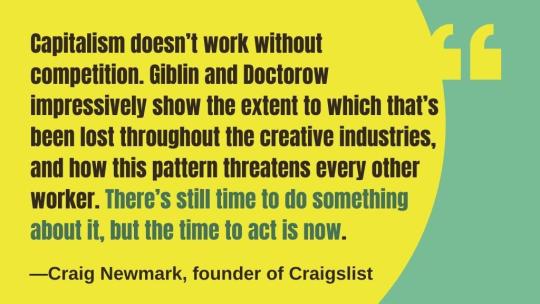
Holy shit, did it ever work. The Kickstarter for the Attack Surface audiobook turned into the most successful audiobook crowdfunding campaign in world history, grossing over $267,000:
https://www.kickstarter.com/projects/doctorow/attack-surface-audiobook-for-the-third-little-brother-book

Which brings me to today, and our new Kickstarter for Chokepoint Capitalism. We produced an independent audiobook, tapping the incomparable Stefan Rudnicki (winner of uncountable awards, narrator of 1000+ books, including Ender’s Game) to read it.
We’re preselling the audiobook ($20), ebook ($15), hardcover ($27), and bundles mixing and matching all three (there’s also bulk discounts). There’s also the option to buy copies that we’ll donate to libraries on your behalf. We’ve got pins and stickers — and, for five lucky high-rollers, we’ve got a very special artwork called: “The Annotated Robert Bork.”
https://www.kickstarter.com/projects/doctorow/chokepoint-capitalism-an-audiobook-amazon-wont-sell

Robert Bork was the far-right extremist who convinced Ronald Reagan to dismantle antitrust protection in America, and then exported the idea to the rest of the world (Reagan tried to reward him with a Supreme Court seat, but Bork’s had been Nixon’s Solicitor General and his complicity in Nixon’s crimes cost him the confirmation).

Bork’s dangerous antitrust nonsense destroyed the world as we knew it, giving us the monopolies that have wrecked the climate, labor protections and political integrity. These monopolies have captured every sector of the economy — from beer and pro-wrestling to health insurance and finance:
https://www.openmarketsinstitute.org/learn/monopoly-by-the-numbers

“The Annotated Robert Bork” is a series of five shadow-boxes containing two-page spreads excised from Bork’s 1978 pro-monopoly manifesto
The Antitrust Paradox
, which we have mounted on stiff card and hand-annotated with our red pens. The resulting package is a marvel of museum glass and snark.
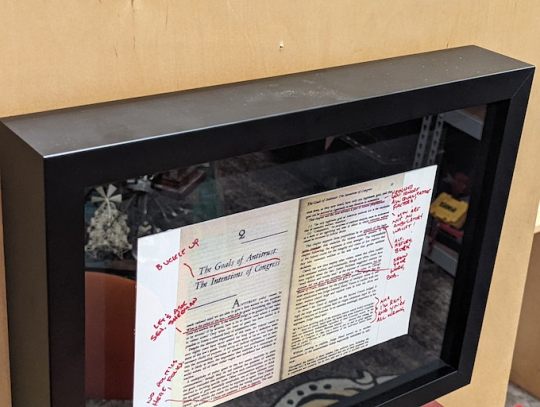
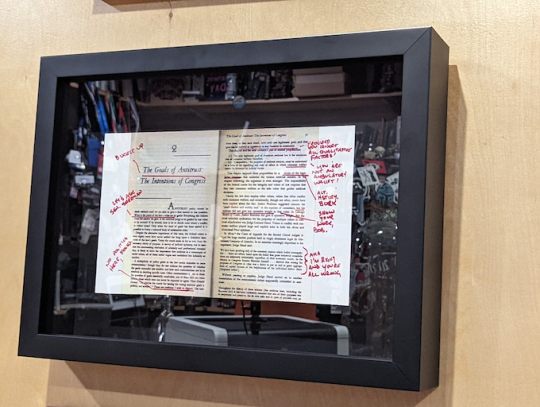
[Image ID: A prototype of ‘The Annotated Robert Bork]
Bork’s legacy is monopolistic markets in every sector of the world’s economy, including the creative industries. Chokepoint Capitalism systematically explores how tech and entertainment giants have rigged music streaming, newspapers, book publishing, the film industry, TV, video streaming, and others, steadily eroding creators’ wages even as their work generated more money for the monopolists’ shareholders.
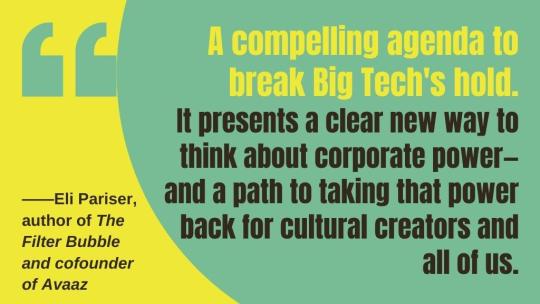
But just as importantly, our book proposes things we can do right now to unrig creative labor markets. Drawing on both existing, successful projects and promising new experiments, we set out shovel-ready ideas for creators, artists’ groups, fans, technologists, startups, and local, regional and national governments.

Artists aren’t in this struggle alone. As we write in the book, chokepoint capitalism is the final stage of high-tech capitalism, which atomizes workers and locks in customers and then fleeces workers as a condition of reaching their audiences. It’s a form of exploitation that is practiced wherever industries concentrate, which is why creators can’t succeed by rooting for Big Tech against Big Content or vice-versa.
It’s also why creative workers should be in solidarity with all workers — squint a little at Audible’s chokepoint shakedown and you’ll recognize the silhouette of the gig economy, from Uber to Doordash to the poultry and meat-packing industries.

40 years of official pro-monopoly policy has brought the world to the brink of collapse, as monopoly profits and concentrated power allowed an ever-decreasing minority of the ultra-rich to extract ever-increasing fortunes from ever-more-precarious workers. It’s a flywheel: more monopoly creates more profits creates more power creates more monopoly.
The solutions we propose in Chokepoint Capitalism are specific to creative labor, but they’re also examples of the kinds of tactics that we can use in every industry, to brake the monopolists’ flywheel and start a new world.
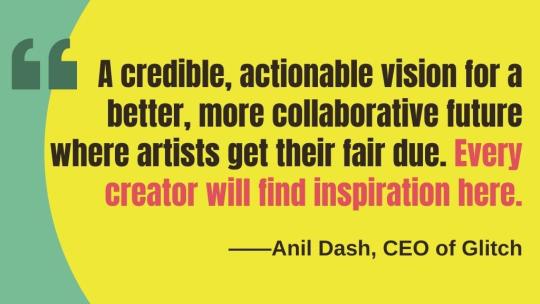
I hope you’ll consider backing the Kickstarter if you can afford to — and if you can’t, I hope you’ll check out one of the copies our backers have donated to libraries around the world:
https://www.kickstarter.com/projects/doctorow/chokepoint-capitalism-an-audiobook-amazon-wont-sell
[Image ID: An image of a mobile phone playing the Chokepoint Capitalism audiobook, along with the title and subtitle of the book: 'Chokepoint Capitalism: How Big Tech and Big Content Captured Creative Labor Markets and How We'll Win Them Back.']
[Image ID: Are you a writer, a musician, an artist? Is Big Tech eating your brain and sucking your financial blood? Cory Doctorow and Rebecca Giblin’s new book, Chokepoint Capitalism’, tells us how the vampires crashed the party and provides protective garlic. Your brain must remain your own concern, however.’ — Margaret Atwood, author of The Handmaid’s Tale]
[Image ID: I loved this book. It brings a clear and rigorous vision of the chokepoint controls that are breaking our spirit and an equally clear path forward. It speaks directly to creators, would-be artists, writers, and musicians, and all who want a free society alive with culture, dissent, creativity. It helps us all see the locks and chains, and the ways to chisel through them.’ — Zephyr Teachout, law professor and author of Corruption in America and Break ’Em Up]
[Image ID: Creators are being ground up by the modern culture industries, with little choice but to participate in markets that weaken their power and economic return. In this brilliant and wide-ranging work, Giblin and Doctorow show why, and offer a range of powerful strategies for fighting back.’ — Lawrence Lessig, Roy L. Furman Professor of Law and Leadership, Harvard Law School]
[Image ID: This compellingly readable indictment shows how ‘consumer welfare’ regulatory theory has allowed Big Tech to choke creators and diminish choice. Giblin and Doctorow demonstrate that the goal to lower consumer costs means ‘you get what you pay for’: paying less for cultural goods leads to getting fewer creative outputs and enterprises. Chokepoint Capitalism couples its legal-economic critique with provocative, sometimes utopian, prescriptions for fairly remunerating authors and performers.’ — Jane C. Ginsburg, Morton L. Janklow Professor of Literary and Artistic Property Law, Columbia University School of Law]
[Image ID: The great myth of the American economy is that it rewards creators and producers. But Chokepoint Capitalism dares to tell the real story of how it actually rewards the all-powerful middlemen fleecing both workers and consumers. This book is an absolute must-read for anyone who senses that the predominant economic mythology is a lie, who wants to know what’s really happening in this economy — and who is ready to finally start fixing the problem.’ — David Sirota, writer of Don’t Look Up and founder of The Lever]
[Image ID: We all know something is wrong about every click, stream, and purchase we make — unfairly depriving value creators of their worth, while enriching the wealthiest and most extractive entities in human history. Instead of just complaining about the corporate stranglehold over production and exchange, Giblin and Doctorow show us why this happened, how it works, and what we can do about it. An infuriating yet inspiring call to collective action.’
— Douglas Rushkoff, author of Throwing Rocks at the Google Bus and Survival of the Richest]
[Image ID: Twenty years of internet copyright wars got us nowhere — creators are still getting the shaft. Giblin and Doctorow persuasively argue that copyright can’t unrig a rigged market — for that you need worker power, antitrust, and solidarity.’ — Jimmy Wales, cofounder of Wikipedia]
[Image ID: Capitalism doesn’t work without competition. Giblin and Doctorow impressively show the extent to which that’s been lost throughout the creative industries, and how this pattern threatens every other worker. There’s still time to do something about it, but the time to act is now.’ — Craig Newmark, founder of Craigslist]
[Image ID: Chokepoint Capitalism really is a tome for the times. It’s comforting to feel validated and terrifying to realize I was right all along! And now, to action! The revolution will not be spotified!’ — Christopher Coe, artist and cofounder of Awesome Soundwave]
[Image ID: If you have ever wondered why the web feels increasingly stale, Chokepoint Capitalism outlines in great detail how it is being denied fresh air. Over the past two decades, we have seen an immense consolidation of power, depriving us of fresh visions for what the web could be and contorting art and culture to flatter the objectives of a few platforms. This book does a remarkable job of identifying the blockages and surfacing ideas on the margins that could reroute us. I’m grateful it exists!’ — Mat Dryhurst, artist and researcher, NYU’s Clive Davis Institute of Recorded Music]
[Image ID: Chokepoint Capitalism is more than a clarion call for a new, necessary form of trustbusting. It’s a grand unified theory of a decades-long, corporate-led hollowing out of creative culture. It will make you angry, and it should.’ — Andy Greenberg, writer for WIRED and author of Sandworm and Tracers in the Dark]
[Image ID: If you’re halfway through this book and aren’t boiling mad over the way contemporary capitalism has deformed and crippled culture, get your head checked. Chokepoint Capitalism is a Why We Fight for a long-overdue uprising. Rebecca Giblin and Cory Doctorow lay out their case in plain and powerful prose, offering a grand tour of the blighted cultural landscape and how our arts and artists have been chickenized, choked, and cheated. But it’s more than just a call to arms; it also provides a plan of battle with inspired strategy and actual tactics — ways that we can all channel that anger and make real change.’ — Kaiser Kuo, host and cofounder of The Sinica Podcast]
[Image ID: The story of how a few giant corporations are strangling the life out of our media ecosystem is one of the most important of the decade, and Giblin and Doctorow tell it better than anyone. Searing, essential, and incredibly readable.’ — Adam Conover, comedian and host of The G-Word]
[Image ID: Chokepoint Capitalism is not just a fascinating tour of the hidden mechanics of the platform era, from Spotify playlists to Prince’s name change, but a compelling agenda to break Big Tech’s hold. It presents a clear new way to think about corporate power — and a path to taking that power back for cultural creators and all of us.’ — Eli Pariser, author of The Filter Bubble and cofounder of Avaaz]
[Image ID: Chokepoint Capitalism is a masterwork. Rebecca Giblin and Cory Doctorow lay out in chilling detail how the deck is stacked against artists, the relentless corporate drives to control production and distribution through technology and deregulation, and how oligopolies deprive gifted artists of fair compensation by eliminating true competition. But they don’t stop there: this is also a useful handbook to take on that power structure. Giblin and Doctorow remind us that when individuals understand the value of their work, they can create the necessary leverage to challenge the status quo and retake what is rightfully theirs. Both frightening and uplifting, it’s a necessary read for any artist in the entertainment industry.’ — David A. Goodman, writer, executive producer of The Orville, and former president of the WGA Wes]
[Image ID: Anyone who cares about culture can see that something is deeply amiss in the ‘creator economy’ that today’s artists are obligated to participate in. Rather than simply lamenting the problem or falling back on clichés about starving artists, what Rebecca Giblin and Cory Doctorow do in Chokepoint Capitalism is to make clear the overall pattern that drives the exploitation of artists, from music to gaming to film to books. And they lay out a credible, actionable vision for a better, more collaborative future where artists get their fair due. Every creator will find inspiration here.’ — Anil Dash, CEO of Glitch]
#pluralistic#labor#creative labor markets#chokepoint capitalism#audible#monopolies#audiobooks#amazon#monopsonies#solidarity#crowdfunding#kickstarter#drm
2K notes
·
View notes
Text

14 years ago, I flew the first Su-57 (PAK FA)
Fernando Valduga By Fernando Valduga 01/29/2024 - 23:10in History, Military
14 years ago, an experimental prototype (T-50-1) of an aircraft created under the "Prospective Frontline Aviation Airborne Complex" program (PAK FA), made its first flight on January 29, 2010. In the last 14 years, the fifth-generation fighter, which became Su-57, has passed almost all the necessary tests and entered service in the Russian Aerospace Forces. But the development has been slow.

The Su-57 is a fifth-generation multifunctional fighter developed by the Sukhoi Company of Russia (part of United Aircraft Corporation). It was designed to compete with other fifth-generation fighters, such as the F-22 Raptor. The aircraft received several designations during the years of development. Sukhoi used the alphanumeric index "owner" "T-50". Government agencies mention it more often in the context of the PAK FA program (Perspektivny Aviatsionny Kompleks Frontovoy Aviatsii). The Ministry of Defense assigned it the designation Su-57, in fact, the military speaks of "an aircraft with its original appearance" (with engines "Product 117") and "aircraft with second stage engine" ("Product 30′′). NATO gave the codename Felon.
youtube
A total of ten T-50 flight prototypes and three of static ground tests were built for preliminary flight tests and state tests.
Since his first flight in 2010 and after going through several rounds of testing and development, he entered service in the Russian Air Force on December 25, 2020 in one of the aviation regiments of the Southern Military District, at Lipetsk Air Base. This initial production batch would be used for military evaluation, tactical development and crew conversion training. The first fully operational Su-57 regiment of 24 aircraft is expected to be equipped by 2025

According to several reports, the unit cost of the Su-57 is estimated at about 40-50 million dollars per aircraft. This makes it significantly cheaper than other fifth-generation fighters, such as the F-35 and F-22, which cost about $80-100 million and $150-200 million per aircraft, respectively.
Although it was put into service by the Russian Air Force in 2020 and, although it has participated in a series of military exercises and test flights, it has not yet been officially used in real combat. However, there have been reports from the United Kingdom intelligence where it was reported that Russia used the Su-57 against Ukraine in 2023.

The Russian Air Force has so far received 22 Su-57 fighters, with plans to acquire additional units in the coming years. These aircraft are part of a larger order of 76 Su-57 announced by the Russian government in 2018.
It is worth mentioning that the production of the Su-57 has been somewhat slow due to delays in the development of the aircraft and problems with its engines, among other factors. However, the Russian government stated that it plans to accelerate the production of the Su-57 in the coming years, with the aim of putting in the field a greater number of these advanced fighters in the Russian Air Force.
Tags: Military AviationRussian Air ForceHISTORYPAK FA/T-50 – Perspektivny Aviatsionny Kompleks Frontovoy Aviatsii— Future Air Tactical SystemSukhoi Su-57 Felon
Sharing
tweet
Fernando Valduga
Fernando Valduga
Aviation photographer and pilot since 1992, he has participated in several events and air operations, such as Cruzex, AirVenture, Dayton Airshow and FIDAE. He has works published in specialized aviation magazines in Brazil and abroad. He uses Canon equipment during his photographic work in the world of aviation.
Related news
MILITARY
Czech Republic officially joins the global F-35 Lightning II team
29/01/2024 - 19:37
MILITARY
Japan and the USA agree on artificial intelligence research for drones to help new fighters
29/01/2024 - 19:04
MILITARY
Pentagon discloses how the training of Ukrainian pilots on F-16 jets in the US is going
29/01/2024 - 16:00
JAS39 Gripen Fighter from the Czech Republic and a U.S. Air Force F-35. (Photo: Martin Král)
MILITARY
Czech Republic and Germany plan future cooperation between air forces
29/01/2024 - 14:00
INCIDENTS
RAF Voyager crew is startled with burst tire during takeoff
29/01/2024 - 11:30
MILITARY
United Kingdom offers replacement of Storm Shadow missiles by German Taurus missiles to help Ukraine
29/01/2024 - 09:30
7 notes
·
View notes